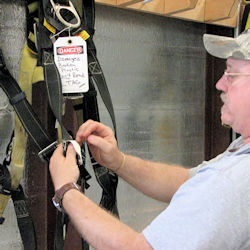Harness Inspection
It is very important that you inspect the components of personal fall-arrest, restraint, or positioning-device systems for damage or excessive wear before and after each use.
Belts: For harness inspections begin at one end, hold the body side of the belt toward you, grasping the belt with your hands six to eight inches apart. Bend the belt in an inverted "U." Watch for frayed edges, broken fibers, pulled stitches, cuts or chemical damage.
- Rivets should be tight and unremovable with fingers. Body side rivet base and outside rivets should be flat against the material. Bent rivets will fail under stress.
- Inspect frayed or broken strands. Broken webbing strands generally appear as tufts on the webbing surface. Any broken, cut or burnt stitches will be readily seen.
- Attachments of buckles and D-rings should be given special attention. Note any unusual wear, frayed or cut fibers, or distortion of the buckles.
Rings: Check D-rings and D-ring metal wear pads for distortion, cracks, breaks, and rough or sharp edges. The D-ring bar should be at a 90 degree angle with the long axis of the belt and should pivot freely.
Tongue Buckle: Buckle tongues should be free of distortion in shape and motion. They should overlap the buckle frame and move freely back and forth in their socket. Rollers should turn freely on the frame. Check for distortion or sharp edges.
Friction Buckle: Inspect the buckle for distortion. The outer bar or center bars must be straight. Pay special attention to corners and attachment points of the center bar.
Knowledge Check Choose the best answer for the question.
8-2. What should you look for when inspecting harness D-Rings?
You forgot to answer the question!

